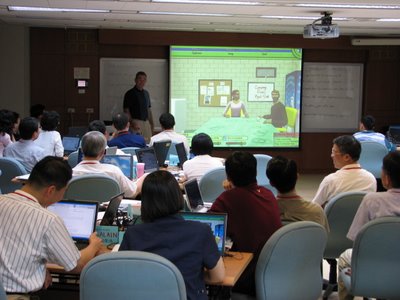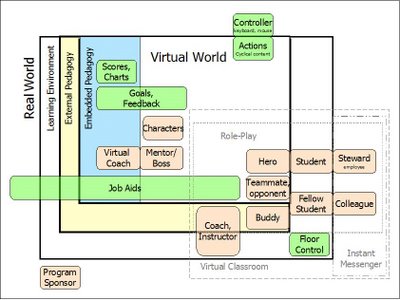Quick question.
How might you describe the different "people" in this room:
 Real people and avatars? Coaches, students, and characters? Teammates and competitors? Buddies? Colleagues? Leader and followers?
Real people and avatars? Coaches, students, and characters? Teammates and competitors? Buddies? Colleagues? Leader and followers?
A challenge in discussing educational simulations is that the same person has different roles, depending on if you are looking at the context of the virtual world, the classroom, and the real world. For example, the same person can be a hero in the context of the sim, a student in the context of the class, and a project manager/steward in the context of the enterprise.
Likewise, coach can refer to an embedded, pre-scripted avatar and/or a real person.
Characters in the sim can only exist in the sim, or be controlled by other students. A colleague of yours (context: real world) can help you either by being a teammate (context: virtual world) or a buddy (context: classroom). (The difference being a teammate helps you in the sim, a buddy helps you understand the sim.)
It is further interesting to note what a simulation adds to the more traditional concept of a role-play.
Productive comparisons and best practices require a common vocabulary. I have working definitions of all of these role, but here's a first draft at a chart to put it all together.

As always, I would appreciate any feedback.




5 comments:
This is such a very informative blog! This will do well for teacher's serminars or lectures. In this case teachers will be able to understand their role as educational intruments and the role of students as educational outputs.
Thanks. The chart is still rough, obviously, and I hope to refine it over iterations.
Clark. I think this an interesting direction in discussion simulations and business gaming as well. Not least the concept of people controlling the primary characters rather than the simulation, and the simulation controlling the environment and context, and maybe some of the bit-parts. This seems far more a) achievable given current technology, and b) actually more flexible. The investment to build complex and realistic simulations, is I still think, beyond the budget of the everyday.
And yes, developing a vocabularly that describes this is helpful too.
David
Clark, thanks for broadening the landscape. I'll piggyback with a parallel area: Second Life. Avatars watching avatars. Reality gets confusing. Maybe Third Life will model Second Life. Ever read Pirandello?
Hello:
I find the work all of you eLearning folk are doing interesting, but many of your projects are hardly simulations of reality... they're elaborate computer games. Any attempts to try and deconstruct reality into mechanical flow charts (like the one provided) are laden with flaws, the largest one being separation from real-life peers in face-to-face, emotionally-charged settings. I understand the general eLearning thesis being bandied about here (read the published books with interest), but staring into a computer screen CANNOT duplicate genuine inter-personal interaction. It's not a simulation at all, these are contextually-detached replicative games. If we want simulations to truly revolutionize education, they need to provide the learner with the targeted contextualized realities. Computer simulations simulate computer-related realities, but not other realities.
Sincerely,
Regan Ross
Post a Comment